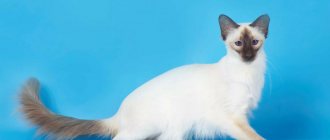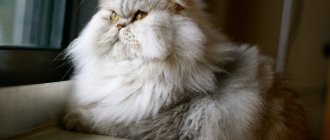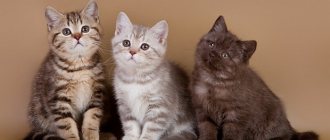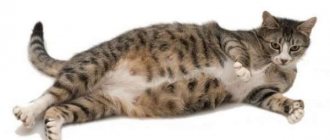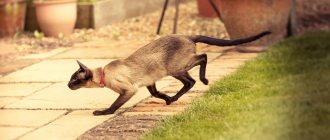Description of the Balinese cat breed
What does a Balinese cat look like? Have you seen the Siamese? Not at all similar! Although, of course, common genes have an effect, neither the character nor the appearance of the Balinese is very reminiscent of the Siamese great-great-great-grandmothers. Pictures and photos of the first Balinese cats show us tightly built, dense animals. But a lot of water has passed under the bridge since then, and the breed standard of the 21st century differs from the standard of the past century.
- Balinese cats must have a wedge-shaped head with a narrow muzzle and a strong jaw. The bite is straight.
The nose is long, without a depression. The profile is smooth.
The ears are very large, triangular, pointed. Placed to continue the wedge line.
The eyes are almond-shaped. The distance between them is equal to the width of the eye, or even more. The eyes are set askew. The color of the iris is blue, blue. Gray coloring is possible, but not desirable. Since Soviet times, there has been a myth that strabismus is a common occurrence for Balinese. This seems to be due to an insufficient influx of “fresh blood” into the breed. Today we can say with confidence that constant squint is a disqualification for a cat.
- The size of the Balinese cat is rather small. At the same time, she is very slender, elegant and strong. The body is elongated, thinning. Shoulders, chest and croup are the same in width.
The limbs are long, the hind legs are higher than the front legs. The paws are oval, the toes are elongated.
The tail is whip-shaped, very long and thin. Moreover, it is thin along its entire length. A break in the tail deprives the cat of the right to participate in exhibitions with all the ensuing consequences.
No matter how much you feed a Balinese cat, she still remains miniature and graceful. The weight of an adult is from 2.5 kg to 5 kg.
- Wool
The Balinese beauty's coat is medium in length and feels silky. There is no undercoat. The fur on the body lies smoothly, but on the chin, neck and tail it is slightly wavy. A plume on the tail is required.
Kittens, by the way, are born with short hair and only in adulthood are covered with the fur characteristic of the breed. Balinese kittens do not immediately captivate with their charm and beauty. Description of the Balinese kitten - short hair, huge ears, awkward. Only an experienced or very loving eye will discern the future elegant beauty in this absurd creature.
- White snowflake - this is what a Balinese kitten looks like. The special Siamese color also appears with age. A Balinese cat can choose any of the 20 colors noted in the breed standard for its coat. Classic colors are blue point, frost point, seal point and chocolate point. There are other options. Solid color is equally acceptable. Cats that are uniformly colored are called Javanese. Red or black coloring is completely unusual for this breed.
Excessive darkening of the body, lack of pigment on the nose or paw pads, dark spots on the belly are defects of the breed. And white fingers are a completely disqualifying sign.
Health
Representatives of this breed are prone to a number of diseases. This may include amyloidosis of the liver and kidneys in adult animals, cardiovascular problems (dilated cardiomyopathy), and oral diseases.
Less common, but also occurring, are diseases such as diabetes mellitus, strabismus, and dysplasia of the hip and elbow joints.
How to determine and not miss the onset of diabetes in a pet? Pay attention to the following symptoms:
- weight gain or sudden loss;
- thirst and excessive urination;
- unusual appetite (increased or decreased);
- loss of mood;
- unbalanced gait;
- acetone in the blood.
If your fears are confirmed and veterinarians diagnose diabetes, do not panic. The disease is corrected and treated. With constant monitoring, the pet will live a high-quality and fulfilling life.
The life expectancy of the Balinese is 15 years.
A unique cat does not require unique care. Regular combing, rubbing eyes and cleaning ears is a classic set of measures to ensure a presentable appearance of Balinese dogs.
IMPORTANT! These cats are made for apartments. They are strictly prohibited from living on the street. Firstly, in the process of their evolution they lost the necessary instincts, and secondly, the unstable climate negatively affects the color and condition of the coat of a Balinese cat.
Maintenance, care, health
Caring for Balinese dogs is largely standard. They should regularly brush their ears and teeth, rub their eyes, and trim their nails.
Balinese wool requires more attention. It is not predisposed to the formation of tangles, so it is enough to comb it once a week with a special brush. During the molting period, this procedure must be repeated at least twice a week.
Low temperatures are contraindicated for Balinese cats, as this can cause their fur to darken. The optimal temperature for them is +22 – 24 degrees Celsius.
Balinese cats do not like to swim, and there is no particular need for this procedure. If it occurs, then it is necessary to use a special shampoo, and wipe it only with a towel, since drying with a hairdryer can negatively affect the animal’s fur.
Story
They come from short-haired Siamese cats, in whose purebred litters kittens with long hair began to appear in the early 30s.
The first registered long-haired kitten of a Siamese couple was born in 1928 in the USA. Such “incidents” happened regularly, but the breeders tried not to advertise it, and long-haired children of short-haired parents spent their lives “on the pillow.”
The natural mutation attracted breeders and they began to crossbreed such previously rejected animals with each other. This work was started by Helen Smith from New York and Marion Dorsey from California, who developed a selection method. In a relatively short time, scientists have achieved pure lines of long-haired Siamese cats.
The breed received its first recognition in 1963, under the name “longhaired Siamese”. After 5 years it received its modern name. In 1965, the breed was registered, and in 1970 recognized as “Balinese” in the Cat Fansiers' Association and TICA, and in 1972 the breed was recognized by FIFe and in 1984 included it in its catalogs. The first Balinese standard was refined in 1967 and revised in 1970. This latest standard was adopted in 1970 by the Cat Fansiers' Association. In 1988, the first blue tabby point Balinese from the Czechoslovak Republic was brought to the USSR.
General description of appearance
According to the standards of the Cat Fansiers' Association, FIFe, GCCF, TICA, the Balinese must be identical to the Siamese, with the exception of the length of the coat. Everything about his body is graceful and flexible, smooth lines are combined with muscularity and excellent physical condition. In a good Balinese, everything should be long and proportional: body, legs, neck, tail.
The head is of medium size, in the shape of an elongated wedge, proportional, on a graceful neck, with wide-set ears, tapering to the muzzle in perfectly straight lines, with a straight profile, strong chin and correct bite.
The profile is straight from the crown to the tip of the nose, without bulges or dips.
The chin is of medium size, developed, its lowest point is located on the same vertical line with the tip of the nose.
The ears are surprisingly large, with a wide base, set wide apart, continuing the lines of the wedge. Straight lines run from the chin to the tips of the ears, forming a triangle, without stopping at the cheekbones.
The eyes are “oriental”, almond-shaped, set obliquely, as if repeating the lines of a wedge. They should be widely spaced, clear, deep blue, the brighter the better. Deep-set, protruding, dull, pale-colored eyes are considered a fault. Strabismus is not allowed.
The body is medium in size, graceful, long on slender high legs with graceful oval paws. An excellent combination of strong bones and developed muscles. The shoulders and hips continue the lines of the tubular body. Hips should not be wider than shoulders. The hind legs are slightly higher than the front legs. Tight belly. Males can be larger than cats.
The tail is long, thin, whip-like, tapering to a sharp tip. No knots or kinks are allowed. The long flowing hair on the tail forms a plume.
The coat is medium length, fine, silky, close-lying, without undercoat. Gradually lengthens from head to tail. The longest hair is on the tail.
The color of the Balinese cat breed is color point. Points are areas of a cat’s body that have a bright, rich coat color: ears, “mask” on the head, lower limbs, tail. All other areas of the body, and this is mainly the torso, are as light as possible and should clearly contrast with the points. On the body, a light shade to match the color of the points is acceptable. The “mask” on the head completely covers the entire muzzle, including the whisker pads, and is in contact with the ears, but does not merge with them. The “mask” should not turn into a “hood” and go to the back of the head. Markings on all parts of the body should be evenly painted and the same color. There should be no white spots or isolated white hairs in the point area. Older Balinese cats tend to have a general darkening of the entire body. Experts are lenient about this.
> Standards
- Balinese cat standard (CFA)
External signs
The Balinese cat has a graceful, elegant silhouette with harmoniously developed muscles, a thin neck and narrow shoulders. She has long thin legs, small oval-shaped feet and a long tail. The head has the shape of an elongated wedge. The ears are wide at the base, their ends are pointed. The eyes are typically oriental, very beautiful, ultramarine color, slightly extended towards the temples.
The cat's fur is long, thin, silky, and does not have a downy undercoat. The face is hidden under a “mask” that reaches to the ears.
Like the Siamese cat, the Balinese has markings on its face, tail, ears and paws. They contrast beautifully with a creamy light background that is slightly darker on the sides and back. Kittens of this breed are born white and acquire color gradually.
History of the breed
Balinese cats as a separate breed were developed relatively recently. One close look at their photo is enough to understand to whom they owe their birth. Balinese cats descended from their Siamese relatives and initially differed from them only in their elongated hair. Several decades in the USA, their homeland, took the formation of this breed. At first, breeders simply selected long-haired Siamese, then began to cross them with each other in order to consolidate their unique feature.
Through long selections in 1970, there was one more cat breed in the world. The appearance of its representatives noticeably deviated from the standard Oriental Siamese. The term “Siamese” has also disappeared from the name of the breed.
In the vast expanses of the former USSR, the first Balinese cat appeared in the late 80s. The first Balinese nursery in Moscow opened in the next decade. At the same time, for the first time in Russia, a stable line of this breed was bred. Nevertheless, even serious efforts by the breeders of these cats cannot yet make this variety popular.
History and breed standard
The Balinese breed was developed in the 40s of the last century in the USA. It was based on Siamese cats, which were carriers of the recessive gene for long hair. As a result of selection, Siamese cats appeared with fairly long hair. They were called Balinese because their plastic movements reminded the breeders who were at the origins of the breed of the movements of dancers from the island of Bali.
In 1970, the breed was recognized by the American Cat Fanciers Association and was given four standard colors: blue, black, chocolate and lilac.
Appearance and characteristics of the breed
The Balinese cat is similar in all respects to the Siamese, except for the length of the coat.
- She is graceful and flexible, and at the same time has a strong and muscular body. Gracefulness is visible in everything: in the long lines and curves of the neck and body, legs and tail.
- A small wedge-shaped head with a pronounced strong chin is crowned with unusually large ears, proportionally expanding the wedge of the head.
- The profile is smooth and straight, without any special bulges.
- The eyes of representatives of this breed are “oriental”, oval in shape, and fit well into the wedge shape of the head. The standard for the breed is considered to be wide-set bright blue eyes. A serious disadvantage will be the presence of deep-set eyes, squint, and pale color.
- Representatives of this breed are generally small in size. Males are usually larger than females. The weight of a mature male can reach 5 kilograms, females – 3–3.5 kg.
- The body is tube-shaped, the hips and shoulders are approximately equal in width. The legs are oblong and elongated, with the front pair being slightly shorter than the back pair.
- The tail is quite long and thin along its entire length, somewhat reminiscent of a whip. The presence of kinks or knots on the tail is considered a disadvantage.
- The Balinese coat is medium in length, without undercoat. The wool feels silky and fine. The longest hair grows on the tail, often in the form of a plume.
- The color of representatives of this breed is color point. The “mask” on the muzzle, ears, tail and lower part of the paws have a bright, rich coat color. The “painted” areas can be of a variety of colors, the main thing is that they are evenly colored and do not have light shades. The body of the Balinese in contrast is as light as possible. Only a slight match in the color of the points is acceptable.
Interestingly, kittens of the Balinese breed are born with short hair. The characteristic cover grows only with age.
In general, kittens of this breed are awkward and do not immediately charm their owners. Short hair, disproportionately huge ears, and seemingly slanted eyes give young Balinese dogs an awkward appearance, but all these childhood shortcomings are more than compensated for in the future. An adult, elegant Balinese cat will attract glances, charm and delight.
The disadvantages of the breed are: excessively dark body, white toes, lack of pigmentation on the pads of the paws or the tip of the nose.
The real beauty of cats of this breed is their character. They are not as independent as many other felines, but this only benefits their owners. The Balinese cat is very curious, she sincerely shares all the interests of her owner. She always wants to be in the center of events, wants to be friends, and demands reciprocal attention. In addition, these cats are extremely active and “sporty”.
Their mobility requires some space and the participation of the owners in entertainment and games. For this, the Balinese cat will be endlessly, like a dog, devoted to its owner, and this is a very rare case for representatives of the cat family.
The sociability and affection of the Balinese allow them to easily make friends with other cats and even dogs. They get along well with children.
Some representatives of the breed like to “talk” for a long time and sincerely, “tell” about what happened during the day, complain about the lack of attention, or, conversely, thank them for the good attitude towards them.
It should not be surprising that with proper and attentive treatment, a Balinese cat will enjoy every minute of communication with its owners and will, for example, take the habit of meeting them every day after work.
Unfortunately, representatives of this breed of cats are susceptible to various diseases. The lion's share of ailments passed to them from the Siamese breed. On average, a Balinese cat, with proper care and timely detection and treatment of diseases, lives about 15 years.
The most common diseases of these animals are inflammation of the respiratory tract. Homeowners should take a closer look at drafts in their homes and also prevent excess humidity.
They are also prone to the following diseases:
- Inflammation of the liver, kidneys and esophagus.
- Diseases of the oral cavity.
- Problems with the cardiovascular system.
- Asthma.
- Increased sensitivity to pain.
- Allergies to certain types of food, paper dust, tobacco smoke.
- Rare but possible: diabetes, strabismus.
When getting a kitten of this species, it is worth remembering that the Balinese cat is a purebred cat, and therefore is more whimsical compared to simple “yard” cats. It is better to seek them from reputable breeders, to nurseries with extensive experience, so as not to subsequently turn your life and the life of your pet into one endless visit to the veterinarian.
Surprisingly, this original cat does not require any unusual care at all. It's quite simple:
- Periodic grooming is important. Combing once a week.
- Wash with a special shampoo for long-haired breeds approximately once a month.
- Nail trimming once a month.
- Oral hygiene, which is best left to specialists.
- Periodic inspection and wiping of eyes and ears as they become dirty.
These simple measures are the key to your pet’s health and activity. And if you also find time for walks together in the fresh air, the cat’s gratitude will have no limits.
Balinese are very unpretentious in food. To feed them, you can use both ready-made mixtures and natural home-cooked dishes. The only recommendation is that it is better not to mix store-bought and home-made food. Dry mixtures of different classes and manufacturers are presented in a wide variety on the shelves of hypermarkets and pet stores. As for food prepared with your own hands, nutritionists have developed certain requirements for it:
- The presence of meat (boiled) is required in a pet's diet. The meat should be dietary: beef or veal. Chicken - no more than twice a week, since it is not very rich in amino acids and cannot fully satisfy the pet’s body. Cooked meat should be cleaned of veins and finely chopped.
- Fish should be used as a main dish - once a week. Moreover, nutritionists recommend cooking only sea fish. It must be subjected to thorough heat treatment, having previously been cleared of bones. River fish may be infected with parasites. It is better not to include it in the cat's menu.
- Required in the cat menu: kefir, warmed sour cream, low-fat cottage cheese. It is better not to offer milk to adults - they, as a rule, do not digest it.
- Whole grain porridge and stewed vegetables are ideal as a side dish for meat.
- It is useful to periodically add mineral complexes and vitamins for cats in powders or capsules to their food.
How much does a Balinese kitten cost?
The Balinese cat is a rather rare animal in the Russian expanses. Obviously, the price of kittens of this breed cannot be too cheap. Although on specialized websites on the Internet you can find offers for the sale of kittens for an amount from two to five thousand rubles.
It is clear that such an attractive price cannot be true. The whole point here is that, under the guise of Balinese kittens, they often offer individuals of other breeds, similar in color and external characteristics, most often Siamese. As a rule, these kittens are not tested for genetic diseases and have significant deviations from accepted standards.
In Russia there are few nurseries engaged in breeding animals of this breed. The cost of a Balinese cat kitten in these nurseries is 10–15 thousand rubles. We are talking about the so-called Pet class, that is, about individuals not intended for exhibition or breeding work. Individuals of higher classes cost 10 thousand rubles or more more.
Reputable breeders give kittens to new owners when they reach twelve weeks of age. At 12–18 weeks of age, they develop a distinct, long coat. They can already be easily distinguished from their Siamese relatives.
The approximate monthly cost of maintaining such a pet is about three thousand rubles, not counting possible costs for veterinarian services. This amount includes initial expenses for the purchase of necessary items: bowls, trays, scratching posts, toys. Monthly expenses for consumables include the purchase of litter for the tray and ready-made food.
Balinese, Balinese or, as it is also called, Balinese breed, bred in the USA as a semi-long-haired variety of Siamese cat.
catalogue of articles
Gerasimova Elena,balinese nursery Dizigner
Balinese, Siamese, Javanese, Orientals - all these breeds belong to the same “family”, and often the same breeders breed them. The only differences are fur length and eye color. It would seem that the approach to breeding these cats should be the same. But it was not there!
First Rule
You can cross Balinese cats with each other and consistently get charming long-haired kittens. With this approach, you will have to forget about getting Balinese dogs that can compete at exhibitions with their short-haired brothers - the Siamese. Breeders of Oriental Shorthair cats are actively working to extremeize the type of their animals. Year after year we observe an increase in the size of the ears, lengthening of the proportions of the body and head in the best representatives of the Siamese breed.
What happens when a breeder breeds longhaired cats with longhaired cats for years? In general, nothing special. In this way, it is possible to achieve marking time and simplifying the type after 2-3 generations. Of course, isolated cases of the birth of interesting representatives of the breed from such matings are possible, but this is rather the exception that confirms the rule.
So, the first rule of a Balinese breeder: do not abuse matings only between long-haired cats.
Second Rule
How do breeders improve the type of Balinese and Javanese? They use Oriental shorthair cats in their breeding programs. Some breed both long-haired and short-haired representatives of the breed as part of their nursery. Others purchase short-haired carriers of the long-haired gene for their cattery. Still others use third-party shorthair producers.
What happens when Balinese cats are crossed with Oriental shorthair cats and why do breeders of the breed do this? As a result of such matings, carriers of the long hair gene with an improved type are born (the so-called variettes or vars). This is a very important stage in the breeding of Balinese and Javanese breeds: obtaining carriers of the improved type of long hair gene (SIA var, OSH var - this is how carriers of long hair are designated in the pedigree). Vars may have longer fur compared to short-haired oriental cats, or they may be no different from them. Subsequently, the Vars are crossed either with each other or with the Balinese to obtain offspring of an improved type.
The second rule of the Balinese breeder: regularly use the best representatives of Oriental Shorthair cats to improve the type of Balinese and Javanese.
Third Rule
When working on improving the type, we must remember that the Balinese as a breed “began” with long hair. Ideally, the coat of our breed should be simple, consisting mainly of guard hairs, thin, with minimal fatty lubrication, gradually lengthening from head to tail. Quite short at the neck and shoulders, it lengthens with a “frill” on the sides, adds a little more length at the “pants”, and reveals itself to us in all the splendor of the plume on the tail. The use of short-haired Oriental cats can negatively affect the quality of the wool of Balinese and Javanese cats.
Modern Siamese and Orientals often have ultra-short hair. When choosing “improvers” for a nursery, it is better to give preference to individuals with “long” hair for this breed. In the pedigrees of variettas, it is desirable to have ancestors with very good quality wool. With this approach, work on improving the type will not turn into work on “pulling out” the coat.
The third rule of the Balinese breeder: in the process of improving the type of Balinese, remember to maintain the quality of the coat.
Of course, there are many more rules, but these three are the main ones. Each breeder makes the decision on exactly how to breed cats within his or her cattery independently, but you should not ignore the above rules.
Intrabreed types
Today we can talk about the American and English types of Balinese. Cats of this breed in Europe are a mixture of very different bloodlines and it is difficult to talk about any unity in their type. Breeders from Europe very successfully use cats of both American and English breeding, producing interesting animals of a modern type. The best European nurseries, of course, have their own “face,” but it is usually created on the basis of American and English lines, so there is no need to talk about the existence of a European type as an independent one.
American type
For decades, the American CFA recognized only cats in 4 Siamese colors as Balinese: with dark brown, chocolate, lilac and blue markings. Until recently, breeding for them was allowed only with Siamese in the same colors. As a result, the American Balinese is thin, light, long-legged, with a beautiful, almost ideal even profile, a magnificent sapphire color of large eyes and a regular, contrasting color. Most of them have rather high-set, albeit large, ears. But within the framework of the small population of the Balinese breed, such breeding slowly but surely came to a dead end. A rush of new blood was needed. The leadership of the CFA met the needs of breeders of longhaired oriental cats and “opened” stud books. Now the Balinese and Javanese in the CFA are one breed with two divisions. Interbreeding is allowed until 2013.
It's sad to write about this, but over the past decade, no new Balinese catteries have appeared in the United States. American breeders are in no hurry to import animals from other countries. The main reason for this approach is that, as they say, it is difficult to find a good animal for breeding that does not have American ancestors in the first four generations of the pedigree.
English type
English Balinese and Javanese have a much more powerful build than American ones. They are massive, covered with thick hair, which often creates the feeling of a “collar”. Although the GCCF standard proclaims the same thing as the CFA standard: The coat is of medium length, soft, silky, without cottony undercoat, almost tightly adjacent to the body. The fur on the tail resembles an ostrich feather.
English-bred cats have low-set ears and medium-sized almond-shaped eyes. They lack grace compared to their American counterparts of the breed, but at the same time they have their own unique charm. They often have a long body and slightly short legs. In England, longhaired and shorthaired oriental cats were crossed with each other at the request of the breeders; there were no restrictions on colors. Longhaired Orientals were called Angoras until 2002.
What English and American Oriental Longhair cats have in common is that they are bred in virtually isolated regions. Until recently, imported animals were used minimally in these countries, but breeders were able to achieve impressive results.
Underwater rocks…
Russian Balinese are closer in type to European mixes, since it was from Europe that the first representatives of the breed were imported to us. The problems that existed in the breed have not disappeared. Inna Vladimirovna Shustrova wrote about this about ten years ago in the article “The modern image of an “oriental beauty””: “There are few Balinese, and their type leaves much to be desired in a number of indicators. 1) insufficient lightness of the bone structure, 2) excessive width of the head at the cheekbones in combination with a flat forehead, 3) the presence of a significant amount of undercoat and semi-down, and, finally, 4) insufficient size, incorrect set and shape of the ears. All these signs (especially the first three) significantly simplify the appearance of the Balinese.”
In addition to these delights, each animal carries with it some positive and negative “baggage”. And what the guys have in their “backpacks”, that is, in their genes, can only be found out through experience. It is a rare breeder who will lay out the problems that his cats have for everyone to see. We can only rely on rumors and personal experience and knowledge of close breeder friends. But this is the risk that you have to take in order to bring worthy representatives of the Balinese breed to your nursery, saving several years on improving the “Russian-made” type of Balinese.
The level of shorthair cats from our breeders allows us to work fruitfully to improve the type of population of Balinese cats that exists in Russia. The main thing is to choose the right “improvers” and be patient.
Any steps to develop the Balinese breed in Russia require a lot of time and money, but the result is worth it: the Balinese is a blue-eyed Personality in a beautiful cat’s body, communication with which makes us happier.
Gerasimova Elena,
balinese nursery Dizigner
Source: https://www.dizigner.ru/articles/my-articles/razvedenie-balijskix-koshek-prakticheskie-sovety-i-nablyudeniya-zavodchikov/
Description of the Balinese cat breed
The grace and elegance of the Siamese and long hair are the main characteristics of the Balinese breed. Muscular, slender body, long legs, neatly folded. Oriental wedge-shaped head with an elongated muzzle, triangular ears located along the cheekbones. Blue, slightly slanted almond-shaped eyes are set widely.
The average size and weight is 5 kg and 30 - 35 cm, the cat is usually much larger than the cat. Weight reaches 15 kg. The tail is straight with a small tassel. The coat is light, soft, thin, without undercoat. Color point color (darkened areas on certain parts of the body: ears, tail, paws and muzzle). In this case, kittens are born white and with short hair; they grow and acquire color closer to adulthood.
There are four main types of colors of Balinese cats:
- black;
- lilac;
- blue;
- chocolate.
There are also tint colors:
- brindle;
- tortoiseshell;
- light cream;
- with red markings;
- brown.
These animals shed little and are very easy to care for. Due to their high intelligence, they are easy to train. They perform well with children and other cats. The character is even and calm. They become very quickly and firmly attached to their owner. Very affectionate and gentle, they need frequent contact with the owner.
Character
One of the main features of the Balinese is his sociability. In addition, he is, one might say, dog-like attached to his owner. A Balinese cat, like a dog, can walk next to its owner on a leash, but it is necessary to ensure that the leash is light and does not spoil the pride of the Balinese - its fur. Cats of this breed love to talk; when the owner returns home, as a rule, a “Balinese aria” awaits him. To be fair, we are happy to say that it is not long, and the cat’s voice is pleasant.
Balinese cats, in addition to their owner, usually have excellent relationships with all members of the household. An exception may be people who do not hide their ill will towards them, but the Balinese will simply bypass such people.
Balinese cats are huge fans of outdoor games. As they say, don’t feed them bread, but let them run around and jump. Children, especially younger and middle-aged children, really like this quality of cats.
Characteristics of Balinese cats
All Balinese women are very active and curious. Much friendlier than Siamese animals, they are sociable and can walk around the home for a long time so as not to inadvertently miss anything interesting. They do not like loneliness and do not know how to be alone. At the same time, cats are quite obstinate and cannot tolerate familiarity and infringement of personal space.
They do not tolerate being shouted at or picked up “forcibly”; they can popularly explain that this manner of behavior does not suit them. Therefore, it is very important to explain to children the rules of behavior with a Balinese woman. A very smart animal, has excellent learning ability and needs good upbringing. The breed is suitable for those who do not leave home for a long time, have an active and balanced character. If a sufficient distance is maintained, it will be suitable for a family with small children.
They are talkative and can communicate with their owner for a long time, making interesting sounds. They need enough space for an active lifestyle. It will be very cool if you can provide your pet with a special house or play complex.
Nutritional characteristics of Balinese cats
Absolutely unpretentious in food. You can feed both ready-made food (preferably premium or super premium) and organic food. She needs meat, cereals, vegetables and vitamin supplements. It is advisable to coordinate the Balinese menu with your veterinarian.
Beef, veal - regularly, chicken meat no more than 2 times a week, sea fish once a week. Whole grain porridge, rice separately. Boiled or steamed vegetables. Fermented milk products, for example, kefir, yogurt, cottage cheese. Eggs no more than a couple per week. All food must be balanced; a lack or excess of nutrients can lead to obesity, diabetes and other diseases in your pet.
Balinese cat
You cannot feed your pet food from the human table: fatty, fried, smoked, spicy foods are prohibited - problems with the gastrointestinal tract are possible, sea fish is also prohibited, there is a high risk of infecting the pet with any parasites. All food must be fresh, especially in the summer and accompanied enough plain clean water.
Why are Balinese pets so rare? Breeding and propagating breeds are not the same thing. When breeding in nurseries, certain traits of cats are fixed, which are necessary for participation and victories at exhibitions.
In order to improve the Balinese breed, they are crossed with Oriental breeds. Only a small percentage of the resulting kittens will have long hair, due to a specific gene. Only long-haired kittens attract commercial attention.
